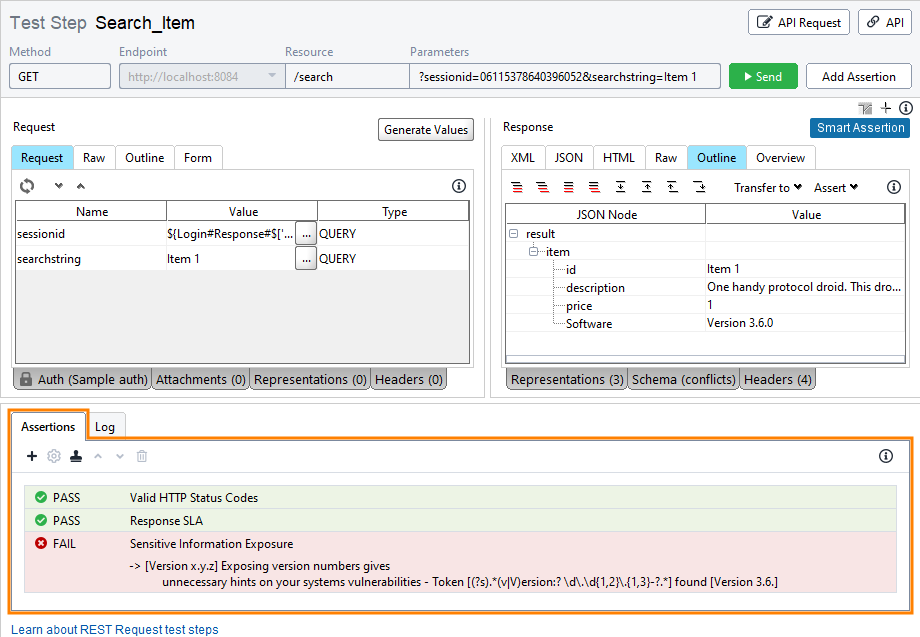Version 3.6 includes improvements to streamline API test development. Below is the list of changes relative to the previous version of the product – ReadyAPI 3.5.2. For information on the changes made to other versions, see Version History.
Endpoints & Environments
The Endpoints & Environments dialog extends the functionality of the previous Environments dialog:
-
We redesigned the dialog for adding and editing endpoints. Now, you have the same experience when you add or edit endpoints in the Endpoints & Environments dialog and on the Endpoints page of the APIs editor. No matter which type of API you use: REST, GraphQL, or SOAP.
-
Now, you can remove endpoints from the Endpoints & Environments dialog.
-
You can copy and paste project properties from one environment to another.
-
Now, you can copy the entire environment to another project. The needed project properties and authorization profiles will be copied as well. To learn more, see Copy environments to another project.
-
Previously, you had to decide whether you create an environment from scratch or copy endpoints from the project. Now, you always create an empty environment.
-
If a request does not have an endpoint specified for the used environment, ReadyAPI will not use the default endpoint - you must specify the needed endpoint for each environment.
-
Default Environment has been renamed to No Environment. Now, this item is always at the top of the environment list.
In its turn, the Endpoints page of the API editor was completely redesigned:
-
Now, it lists endpoints across all the environments.
-
Instead of the obsolete Username, Password, and Domain fields, each endpoint uses an authorization profile.
-
You manage endpoints the same way you do it in the Endpoints and Environments dialog.
Assertions tab
We improved the Assertions tab for the REST Request, GraphQL Query Request, GraphQL Mutation Request, SOAP Request, HTTP Request, and XML-RPC Request test steps. Now, it has a better and cleaner interface:
-
The new Assertions tab is now always visible in the request test steps.
-
The entire assertion's row is now highlighted to show if it passed or failed:
-
The assertions tab without assertions looks more informative.
API management
We also improved the way you manage APIs in your project:
-
The dialog for adding REST resources has become cleaner and easier to use:
-
We have split the functionality of the Add API dialog into three separate dialogs:

-
Use the Create API Definition dialog to create an API from scratch.
-
Use the Import API Definition dialog to import an API from a definition file: either local or remote file (OpenAPI\Swagger, WADL, WSDL) or a definition from SwaggerHub.
-
Discover API - use it to create an API by exploring an existing API. See Discovering APIs.
-
-
To make the process of creating a new project more straightforward, we have removed the Create Project dialog. Now, after you create an empty project, you use the dialogs mentioned above to populate the project with the needed APIs.
-
The Overview tab for the REST, GraphQL, and SOAP APIs has been removed.
More
-
GraphQL improvements:
-
GraphQL APIs in the Navigator menu now have a flyout menu:

-
You can generate a test suite from the GraphQL API.
-
When you add a GraphQL request to a test case, you have the same dialog as in REST and SOAP APIs.
-
-
We updated the Preferences dialog:
-
Tabs of the Preferences dialog are grouped into categories.
-
The interface of the Preferences dialog has become cleaner.
-
You manage GitHub, GitLab, and Bitbucket accounts in the Properties dialog.
-
-
Locally stored properties are now available in security and load tests and in virtual APIs.
-
The Postman plugin now supports variables.
-
We have fixed a few bugs reported by our customers.
-
We’ve updated a few third-party libraries to make the product even more reliable and secure. If your scripts refer to classes from these libraries, you might need to update the scripts.






